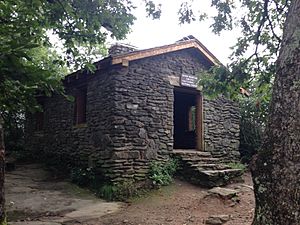Blood Mountain facts for kids
Quick facts for kids Blood Mountain |
|
|---|---|

Blood Mountain, as seen from Vogel State Park
|
|
| Highest point | |
| Elevation | 4,458 ft (1,359 m) |
| Listing | Mountains of Georgia |
| Geography | |
| Parent range | Blue Ridge Mountains |
| Topo map | USGS Neel Gap |
| Climbing | |
| First ascent | unknown |
| Easiest route | Appalachian Trail, other trails |
Blood Mountain is a super cool place in Georgia. It's the highest point on the Appalachian Trail in Georgia! It's also the sixth-tallest mountain in the whole state. This mountain stands tall at about 4,458 feet (1,359 meters) high.
You can find Blood Mountain right on the edge of Lumpkin County and Union County. It's part of the huge Chattahoochee National Forest and a special protected area called the Blood Mountain Wilderness. Around the mountain, there are many beautiful waterfalls, fun hiking trails, and other places to explore.
Blood Mountain is also the highest point where water starts its journey towards the Apalachicola River. This means it's the tallest spot in any land that eventually drains into the state of Florida.
Contents
Why is it Called Blood Mountain?
Have you ever wondered how Blood Mountain got its name? There are a few interesting ideas!
Some people believe the name comes from a big, old battle. They say a long time ago, there was a bloody fight between the Cherokee and Creek Native American tribes right on the mountain.
Another idea is that the name comes from the mountain's colors. Some folks think it's because of the reddish color of the lichen (a type of plant that grows on rocks) and Catawba plants found near the very top. So, it might just be named after its natural look!
Hiking and Fun on the Mountain
Blood Mountain is a fantastic spot for outdoor adventures! From the top, you can see amazing views from the huge rock formations. It's a perfect place to take pictures and enjoy nature.
Cool Places to Visit
At the very top of the mountain, there's a special place for hikers. It's a stone cabin called a hiker's shelter. The Georgia Appalachian Trail Club takes care of it. This shelter was built way back in 1934 by a group called the Civilian Conservation Corps. They were a government program that helped people find jobs during tough times by building parks and trails. This historic cabin was added to the National Register of Historic Places in 2013.
At the bottom of the eastern side of the mountain, you'll find the Walasi-Yi Interpretive Center. This center has a hostel (a place for hikers to stay) and a store. It's located at Neel Gap, where the Appalachian Trail crosses U.S. Highway 19/129. The Walasi-Yi Center started as a log cabin built by a logging company. The Civilian Conservation Corps later made it bigger and stronger between 1933 and 1938. Today, the Appalachian Trail actually passes right through the breezeway of this building! It's the only place on the entire trail where it goes through a man-made structure.
Hiking Trails
There are a couple of ways to hike up Blood Mountain:
- Steep but Scenic Trail: You can take a short but steep trail that's about 2 miles (3.2 kilometers) long. It climbs about 1,800 feet (549 meters) to the top. This trail starts from a parking area near the Walasi-Yi Center. As you walk, you'll see great views. The last 1.5 miles (2.4 kilometers) of this path have many switchbacks, which are like zig-zag turns to help you climb. This is one of the most popular parts of the Appalachian Trail in Georgia!
- Easier Trail: Another way to reach the top is from Lake Winfield Scott. You can take the Slaughter Creek Trail. This path is easier to hike and has places to camp. You'll also find sources of water that you can treat to drink.
Nature Around the Mountain
Near Blood Mountain, you can see large areas with big rocks. There are also forests with northern hardwood trees and huge buckeye trees. Some parts of the area were used for logging a long time ago. Now, you can see fast-growing tulip poplar trees there.
Nearby Attractions
Close to Blood Mountain, you can visit other cool places:
- DeSoto Falls Scenic Recreation Area and campground.
- Vogel State Park, which is great for camping and exploring.
- Sosebee Cove Scenic Area, known for its beautiful plants.
All these places are easy to get to from Blood Mountain, either by hiking trails or by road.




